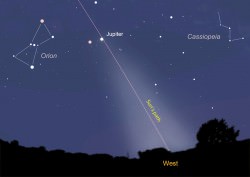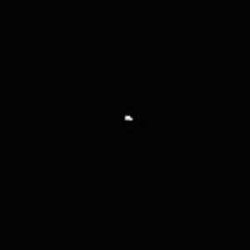When you think of the asteroid belt, you probably imagine a region of rock and dust, with asteroids as far as the eye can see. Such a visual has been popularized in movies, where spaceships must swerve left and right to avoid collisions. But a similar view is often portrayed in more scientific imagery, such as the artistic rendering above. Even the first episode of the new Cosmos series portrayed the belt as a dense collection of asteroids. But the reality is very different. In reality the asteroid belt is less cluttered than often portrayed. Just how much less might surprise you.
The Sloan digital sky survey (SDSS) has identified more than 100,000 asteroids in the solar system. Not all of these lie within the asteroid belt, but there are about 80,000 asteroids in the belt larger than a kilometer. Of course there are asteroids smaller than that, but they are more difficult to detect, so we aren’t exactly sure how many there are.

We have a pretty good idea, however, because the observations we have indicate that the size distribution of asteroids follows what is known as a power law distribution. For example, with a power law of 1, for every 100-meter wide asteroid there would be 10 with a diameter of 10 meters and 100 with a diameter of 1 meter. Based upon SDSS observations, asteroids seem to follow a power law of about 2, which means there are likely about 800 trillion asteroids larger than a meter within the belt. That’s a lot of rock. So much that sunlight scattering off the asteroid belt and other dust in the solar system is the source of zodiacal light.
But there is also a lot of volume within the asteroid belt. The belt can be said to occupy a region around the Sun from about 2.2 to 3.2 times the distance from the Earth to the Sun from the Sun (AU), with a thickness of about 1 AU. A bit of math puts that at about 50 trillion trillion cubic kilometers. So even though there are trillions of asteroids, each asteroid has billions of cubic kilometers of space on average. The asteroid belt is hardly something you would consider crowded. It should be emphasized that asteroids in the belt are not evenly distributed. They are clustered into families and groups. But even such clustering is not significant compared to the vast space it occupies.

Credit: NASA
You can even do a very rough calculation to get an idea of just how empty the asteroid belt actually is. If we assumed that all the asteroids lay within a single plane, then on average there is 1 asteroid within an area roughly the size of Rhode Island. Within the entire United States there would be about 2000 asteroids, most of them only a meter across. The odds of seeing an asteroid along a cross-country road trip, much less hitting one, would be astoundingly small. So you can see why we don’t worry about space probes hitting an asteroid on their way to the outer solar system. In fact, to get even close to an asteroid takes a great deal of effort.


2000 asteroids in the USA (continental? with Alaksa?) is a useful visual image to have in mind.
BUT
it’s a little unfair because the fastest we travel across the USA is in an airplane at a few hundred miles per hour. But space probes are traveling tens of thousands of miles per hour, typically.
I think the continental US makes for an interesting size scale. However, you would need 6 x 10^10 continental USAs to cover the entire Main Belt from 2.0 to 3.3 AU. When I think of it that way, it’s actually a terrifyingly large number of asteroids, even if they are very tiny and very far apart!
Speed difference is only an imaginary problem. Any satelite would travel in the same orbital direction and almost at the same speed as asteroids.
_
Besides that …
Turn the /whole/ USA into a highway, with 2000 cars.
Compare that ~250 -million- registerd cars in the USA
_
And you’ll know why the chicked crossed the road.
The article was interesting up until: “an area roughly the size of Rhode Island”
Considering this is a publication that goes world wide, I am sure there are many readers who have no idea how large Rhode Island is. Is it the same size as Motupore Island in Papau New Guinea?
Probably because readers outside the US are more well versed in geography than the typical Amurican…
I, as European, would call me well versed in geography, but I have no f#in clue, without looking it up, what the size of Rhode Island is. I think that is a “unit” more known to US citizens than to us.
But now I know that RI is a bit larger than Luxembourg. Which is as large as the Saarland, a well known “unit” here 😉
I cringe every time I see a graphic like the one on a, supposedly, science show like the Cosmos reboot, of the asteroid belt. To be fair, everyone does it. And I understand why. Because if you stood on one asteroid you could not see another with the naked eye. Not very dramatic, ehh? But I’m a big fan of reality.
So what I always wonder is, if all those rocks were put together, how big a planet would they make? I used to also wonder why they don’t make a planet over time, but I have recently been given to understand (if I have heard it correctly) that the tidal forces of the Sun and Jupiter keep that area in pieces, so over billions of years it can’t coalesce. Still, I wonder how big a planet it WOULD make if only…
From Wikipedia, Asteroid belt – Characteristics: